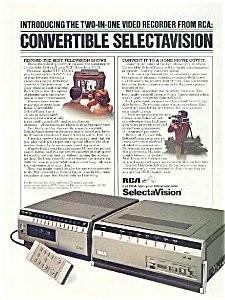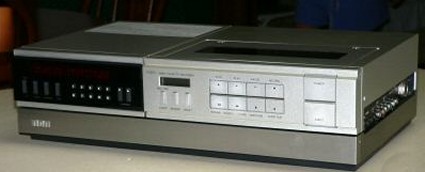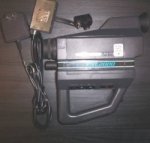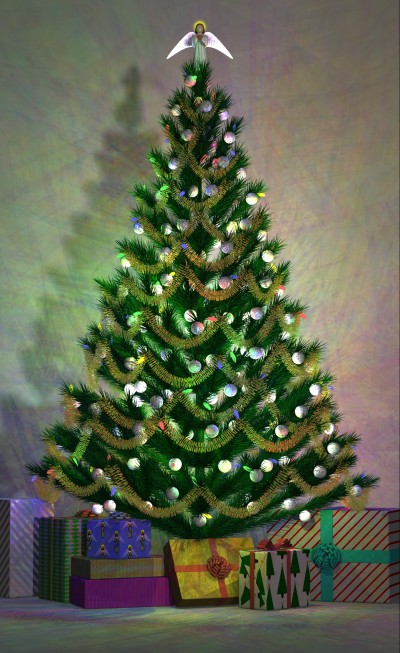This is the seventh in a series of articles about my recent quest to replace a broken VCR in this era of DVDs, DVRs, and other newfangled gadgets. Click here for the beginning of the series.
For many, many years it’s been relatively easy to connect TVs and VCRs to cable systems. The cable simply comes in from the wall, goes into the VCR, comes out of the VCR, and goes into the television. If you wanted a slightly better picture quality out of your VCR you could also connect AV cables from the VCR to the television. These consist of a set of three red, white, and yellow RCA-style cables that transmit video on yellow and left and right audio on white and red cables respectively. In fact that you have a stereo VCR and a stereo television, these AV cables were the only way you can get to stereo sound out of your VCR. Although the cable signals coming from the cable company have stereo audio in most cases, and the VCR tuner is capable of decoding a stereo audio signal and recording in stereo. The Channel 3 or Channel 4 output of VCR does not output stereo audio to your television. Many people don’t realize that but they don’t seem to notice.
Over the years the number of cable channels increased dramatically. At one point Time Warner cable had channels all the way into the low 90s but in more recent years these analog cable channels only reach up to Channel 74 and then skip to 98, 99 on our system. As our cabin in Brown County, the cable system we use only goes up to about 48 and then skips to 98, 99.
Because the capabilities of analog cable had been maximized, the cable companies have come up with a new system to add more channels and more features such as pay-per-view and video on demand as well as onscreen channel guides. They achieve these additional channels and features using what is called “digital cable”. Again we now needed some sort of cable converter box. Fortunately a modern cable box has a remote-controlled electronic tuner and tons of features. The modern digital cable box is actually a small computer connected to the cable company on a computer network that runs through the cable lines. It’s sort of like a closed internet system. Each cable box has an IP address just like the computers on the internet. Information travels both ways along the network. The cable company sends information to your cable box and the cable box can send information back to the cable company. This facilitates such features as pay-per-view and on demand viewing. The cable company can even upgrade the software in the cable box to add new features in the future.
Channel numbers starting at 100 and upwards are not transmitted using traditional analog television signals. Rather they are transmitted as computer information stored in compressed digital form. They can transmit many more channels using the same amount of bandwidth if they are transmitted in this digital form. As many as six digital channels can be transmitted using the same bandwidth as a single analog channel. The real problem is that your so-called cable ready TVs and VCRs can no longer directly access these channels.
Most of your premium channels such as HBO, Showtime, Cinemax as well as some of the more obscure cable channels have all been moved into these digital channel numbers. But for the most part the most popular basic cable channels are still in the 2-99 range that are accessible from cable ready TVs and VCRs. These include all of your broadcast channels which are retransmitted through the cable, ESPN, ESPN2, all the cable news stations, history, discovery, TBS, TNT etc.
A typical hookup for one of the systems is as follows: the cable comes in from the wall and goes into a RF splitter. One of the outputs of the splitter goes to the cable box. The other output goes to your VCR. Your cable box is then connected to your television using red, white, yellow AV cables although some people use a short RF cable. Note that using an RF cable to connect your cable box to your TV means you do not get stereo audio. Also you connect the output of your VCR to another AV input on your TV. If you have a three-way cable splitter you can also connect a third RF connector directly to your TV which gives you even more capabilities.
Given this set up, you can simultaneously watch any cable channel through the cable box and record any analog cable channel to your VCR. Or alternatively you can use your VCR to record a digital channel through the cable box and watch and analog channel on your TV. The only thing you can not do is record one digital channel while watching a different digital channel.
For many years I had a cable box in the living room and in my bedroom. If I desperately needed to record two digital shows at the same time I could record one of them in the living room and one of them in the bedroom.
People who have satellite dishes have to have a satellite box to watch any channel. All the channels from a satellite are digitally encoded. There is no analog cable when using a satellite and so a cable ready tuner doesn’t do any good. Satellite users either need a separate satellite box for the VCR or they cannot watch and record two different things simultaneously. (Note: some satellite boxes are dual tuner so you can record and watch different things at once but most are single tuner.)
This limitation of satellite and the expanded capabilities of analog cable are the main reasons I’ve always had cable rather than satellite.
The consumer-electronics industry realized that it had innovated its way away from one of its greatest interventions: the cable ready tuner. They convinced the cable industry to come up with a new system called a “Cable Card”. Newer top-of-the-line HDTV’s have been made with a slot where you can insert small electronic card about the size of a credit card. You rent this card from your cable company for about $1 a month. It allows your television to receive all of the digital and analog channels that your cable system uses. With such a card, you would no longer need a cable box and your television would once again be cable ready.
Recall that I said cable boxes actually have two-way communication between you and the cable company. Such two-way communication is necessary for the onscreen guide, pay-per-view and on demand services. Unfortunately the cable card system is only a one-way system so the advantages of these features are not available if you have just a cable card. I never used pay-per-view and have rarely used on demand services but I would really miss the onscreen cable guide. My HDTV in the living room has a cable card slot but I still use my regular cable box anyway. I’ve never seen a VCR or DVD recorder that is cable card ready although I have read that some DVR/TiVo recorders may have cable card slots. In fact if your DVR needs to record two shows at once it actually needs two cable cards. The latest TiVo model HD DVR has two cable card slots.
The cable industry is still arguing over standards for a more useful two-way cable card system. So if we ever get full cable ready TVs with a second-generation cable card, it’s going to be a long way off. One of the problems is that the cable industry can charge you more for the rental of a cable box than they can charge for a cable card. They can also customize their features more easily in a cable box. Although they want happy customers who can easily use their service it is not completely in their best interest to adopt cable card technology.
Given that the cable card system really isn’t as functional as it could be and given the increased flexibility provided by cable ready tuners in TVs and VCRs, you would think that the consumer-electronics industry would want to keep cable ready tuners available in TVs and VCRs for the foreseeable future.
By the way, although these articles have been focusing mostly on VCRs, the
same thing holds true for DVD recorders and digital hard drive recorders such as TiVo and DVRs. Cable ready tuners are disappearing from these devices as well.
In our next installment we will try to determine if this absence of tuners is a limited thing overly widespread and we will try to discover the reasons why it is occurring.
 As I mentioned earlier, my Toshiba VCR is probably my favorite. I really wanted to replace it with another Toshiba model. I went to
As I mentioned earlier, my Toshiba VCR is probably my favorite. I really wanted to replace it with another Toshiba model. I went to 







